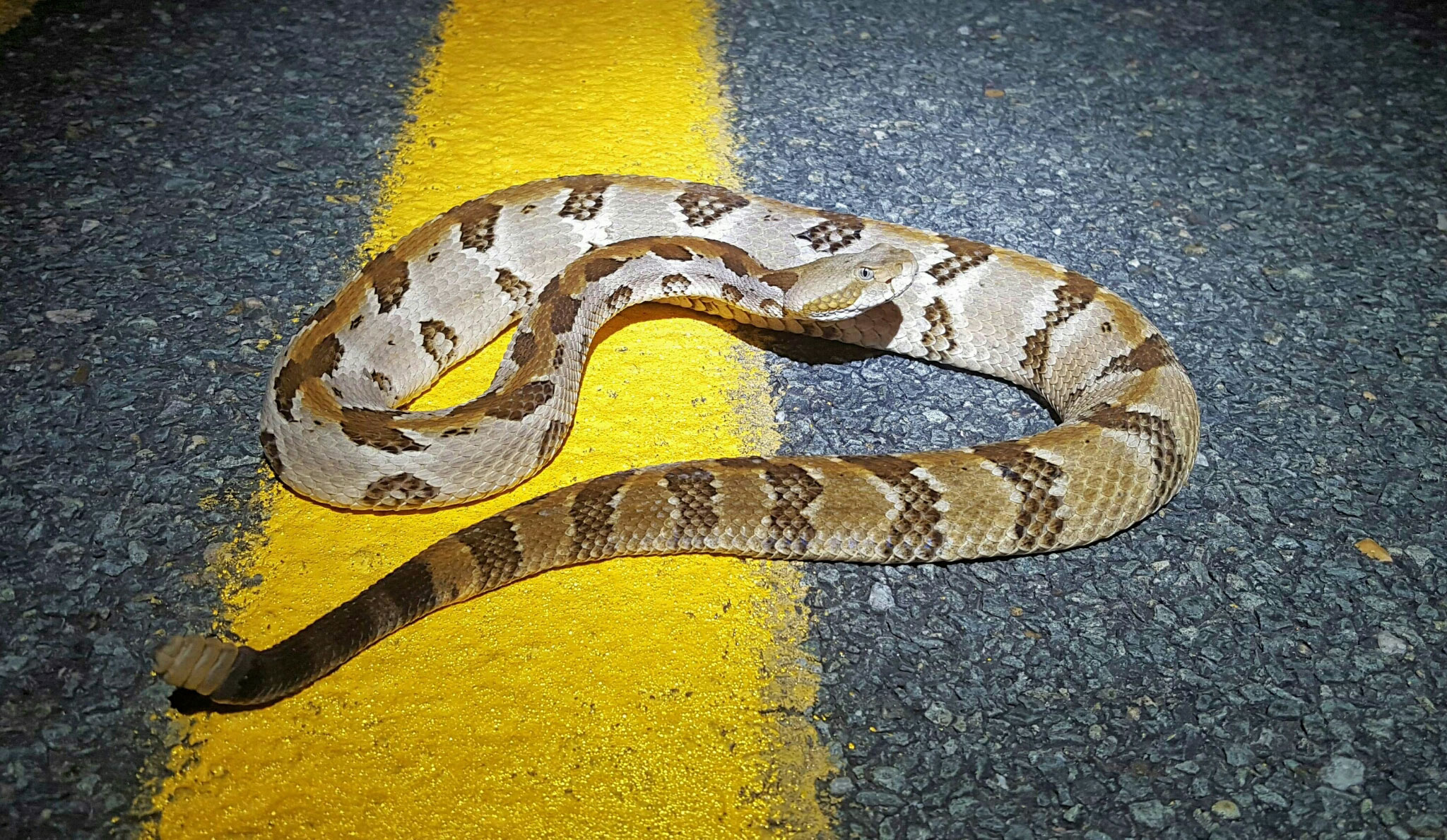
Summer in Southern Appalachia affords many opportunities to watch and learn more about our diverse species of wildlife. Near the border of Western North Carolina and East Tennessee, I see migrating and breeding birds, wild turkeys rearing poults, white-tailed deer with their fawns, and the occasional black bear.
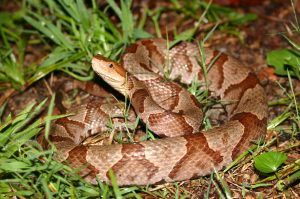
By far the most exhilarating sightings are of snakes. Last year, between mid-July and mid-August, I saw four rattlesnakes and one copperhead on my property. This year in late June, two rattlers passed through in one day.
I’m always excited to share these thrilling glimpses into the natural world. But not everyone shares my enthusiasm for elongated, limbless reptiles.
In Great Smoky Mountains National Park, “visitors are afraid of venomous snakes” according to Supervisory Wildlife Biologist Bill Stiver. He recalls being at a firearms training at the Mingus Mill range and “having a visitor approach us and tell us how he shot and killed a rattlesnake up the trail. He seriously thought he was doing us and other visitors a favor.”
That individual had to pay a fine. It is illegal to kill timber rattlesnakes not only in GSMNP but in the entire state of Tennessee. They’re also protected by the North Carolina Endangered Species Act.
Stiver is called upon to remove venomous snakes from developed areas such as campgrounds, visitor centers, and mills. “We generally do not move them very far,” he said, citing expert advice that “if you move them out of their home range, there is a good chance they will die.”
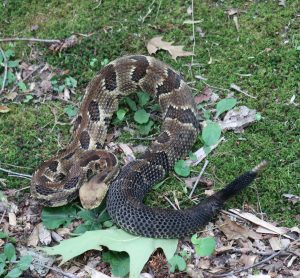
Helping to educate and protect visitors near Cades Cove Visitor Center is park volunteer, certified master herpetologist, and venomous snake handler Walt Peterson.
“Copperheads hang out around the millstones, and I tape off the area to keep the public safe, as people often sit on these stones,” he said. “The snakes are a great source of interpretation, and it seems people are as eager to see them as the mill.”
Peterson said the most common question he hears is, “Is it poisonous?” This provides an opportunity to educate visitors: “Quite simply, if you bite it and get sick, it’s poisonous. If it bites you, and you get sick, it’s venomous.”
He also hears—and attempts to dispel—a lot of “snake myths.” One involves a common misconception that people have been “chased by snakes.”
“From a snake’s point of view, people look like very large predators,” he said. “Snakes will usually freeze, thinking you won’t see them, then slither away if possible. Sometimes that escape route is behind you, giving the impression that they are chasing you.”
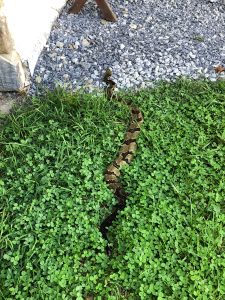
University of North Carolina Asheville professor R. Graham Reynolds has made a career of studying reptiles, even discovering some new snake species in tropical climates. He said our region’s timber rattlesnake and eastern copperhead are both pit vipers, closely related members of the same family, Viperidae.
“They are ambush predators, which means they usually find a productive place to wait for their prey to come to them,” Reynolds said. “Timber rattlesnakes famously can stay put for quite some time—hours to days—waiting for a mouse to walk by. Mice are very warm relative to their environment, and the snake can detect this warmth using the pits in its snout to ‘see’ the infrared signature of the mouse.”
Copperheads, which are nocturnal and fantastically camouflaged, also have heat-sensing pits and eat warm-blooded mammals like mice and birds. Their diet includes amphibians like frogs as well as insects and other non-warm-blooded prey.
“The venom works to immobilize the prey quite quickly,” Reynolds said. “It is dangerous to the snake to grab a mouse or a bird and risk being bitten or pecked. So, these snakes generally bite, release, then track down their envenomated prey.”
Snakes in our region need to move between habitats seasonally. Our cold winters require them to find locations where temperatures stay relatively stable without getting too cold. Once the season changes, they make short migrations to habitats where they can feed and reproduce.
“Often these movements happen around the same time when the conditions change,” Reynolds said. “So, you will sometimes observe several snakes in one day after not having seen any for a season. While snakes don’t follow trails the way many mammals do, they sometimes move along the same areas as other snakes if there are few obstructions and enough places to hide if needed.”
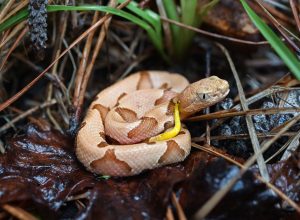
And hiding is something at which snakes excel. Peterson said humans see only about 10 percent of the snakes that are around, and Reynolds has repeatedly seen hikers walk right past a snake on a trail. He adds that copperheads are quite good at living near humans, often without being detected, and most bites occur because a person was provoking or handling the snake.
In fact, recent scientific studies show that vipers in general are loathe to strike. A 2020 article titled “Don’t Tread on Me” reveals the research of Adams et al. demonstrating that only two out of 69 copperheads attempted to bite when intentionally provoked. The paper cites herpetologist Clifford H. Pope, who wrote in 1958 that snakes are “first cowards, then bluffers, and last of all, warriors.”
“Both our venomous snakes are very reluctant to strike people and will do so only when they feel trapped or otherwise threatened,” said Reynolds. “I have stepped over several copperheads, for example, and they just lie there.”
Of annual US deaths, 72 can be attributed to insect stings, 30 to dog bites, and only five to snake bites. Of these five victims, some had underlying medical conditions or failed to seek treatment according to Peterson, who noted that, surprisingly, in 25 percent of snake bites no venom is even injected.
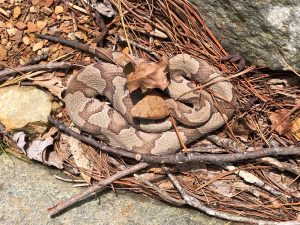
“The biggest threat from timber rattlers and copperheads in the park comes from people unknowingly placing hands or feet too close, especially around buildings, rocks, and logs,” he said.
Why are snakes sometimes found near human dwellings and structures like the park’s visitor centers or my house in East Tennessee? Reynolds said it’s often because that is simply where humans “look.”
“You might move a woodpile across your yard and discover a copperhead, but you probably do not move a woodpile out in the woods. It might also be said that humans are found close to snake dwellings, as sometimes the places that people like to live—sunny, south-facing slopes with creeks running nearby—are also preferred habitats of some snakes.”
Snakes exhibit preference for particular areas called “home ranges.” So, they will often return if only moved a short distance. Only certified snake handlers such as those mentioned in this article can legally relocate venomous snakes. There are now social media groups that help people contact their nearest authorized snake handler.
Globally, the largest threat to snakes is, of course, humans, and a seemingly universal desire to destroy them based in a lack of education. Reynolds said this is leading to the likely extinction of a number of snake species.
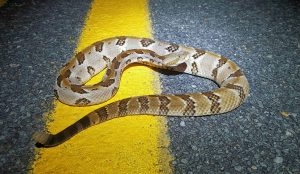
“Snakes can only defend themselves within a body length or two of themselves and will only do so when directly threatened,” he said. “Since it is within the powers of each person to decide what they value and what they don’t value, we have the opportunity to reset how we interact with nature.”
Predators, snakes included, are important members of ecological webs that link living things together in communities. Disruptions like the killing of snakes ripple throughout the local biotic community, reducing overall biodiversity. We cannot allow this kind of interference in areas we wish to protect for their ecological value.
“Snakes, like other misunderstood species, have a right to existence that goes beyond their utility to humans,” said Reynolds. “If you don’t love snakes, that’s okay; just give them their space. But perhaps you might find a spark of the joy and excitement that comes with seeing a wild snake, the way that I and so many thousands of other people in this region do.”
Subscribe to get the latest posts sent to your email.
The Great Smokies Welcome Center is located on U.S. 321 in Townsend, TN, 2 miles from the west entrance to Great Smoky Mountains National Park. Visitors can get information about things to see and do in and around the national park and shop from a wide selection of books, gifts, and other Smokies merchandise. Daily, weekly, and annual parking tags for the national park are also available.